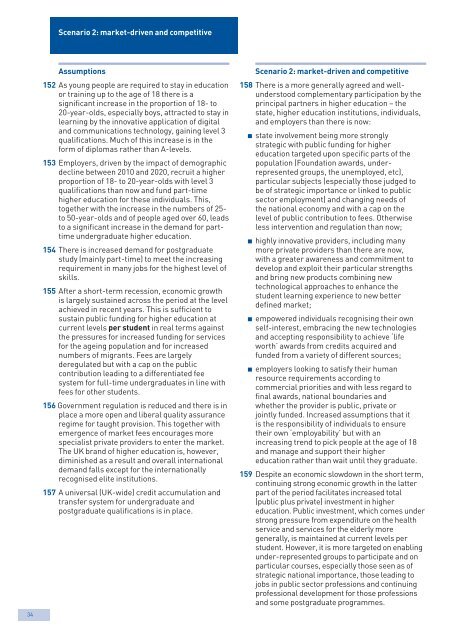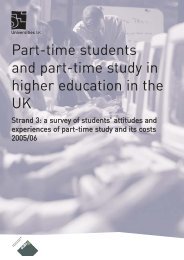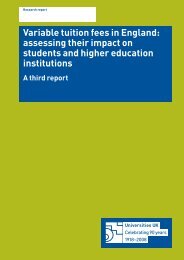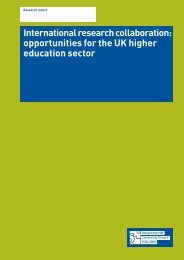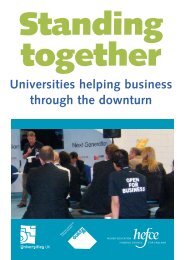The future size and shape of HE - Universities UK
The future size and shape of HE - Universities UK
The future size and shape of HE - Universities UK
- No tags were found...
You also want an ePaper? Increase the reach of your titles
YUMPU automatically turns print PDFs into web optimized ePapers that Google loves.
Scenario 2: market-driven <strong>and</strong> competitive34Assumptions152 As young people are required to stay in educationor training up to the age <strong>of</strong> 18 there is asignificant increase in the proportion <strong>of</strong> 18- to20-year-olds, especially boys, attracted to stay inlearning by the innovative application <strong>of</strong> digital<strong>and</strong> communications technology, gaining level 3qualifications. Much <strong>of</strong> this increase is in theform <strong>of</strong> diplomas rather than A-levels.153 Employers, driven by the impact <strong>of</strong> demographicdecline between 2010 <strong>and</strong> 2020, recruit a higherproportion <strong>of</strong> 18- to 20-year-olds with level 3qualifications than now <strong>and</strong> fund part-timehigher education for these individuals. This,together with the increase in the numbers <strong>of</strong> 25-to 50-year-olds <strong>and</strong> <strong>of</strong> people aged over 60, leadsto a significant increase in the dem<strong>and</strong> for parttimeundergraduate higher education.154 <strong>The</strong>re is increased dem<strong>and</strong> for postgraduatestudy (mainly part-time) to meet the increasingrequirement in many jobs for the highest level <strong>of</strong>skills.155 After a short-term recession, economic growthis largely sustained across the period at the levelachieved in recent years. This is sufficient tosustain public funding for higher education atcurrent levels per student in real terms againstthe pressures for increased funding for servicesfor the ageing population <strong>and</strong> for increasednumbers <strong>of</strong> migrants. Fees are largelyderegulated but with a cap on the publiccontribution leading to a differentiated feesystem for full-time undergraduates in line withfees for other students.156 Government regulation is reduced <strong>and</strong> there is inplace a more open <strong>and</strong> liberal quality assuranceregime for taught provision. This together withemergence <strong>of</strong> market fees encourages morespecialist private providers to enter the market.<strong>The</strong> <strong>UK</strong> br<strong>and</strong> <strong>of</strong> higher education is, however,diminished as a result <strong>and</strong> overall internationaldem<strong>and</strong> falls except for the internationallyrecognised elite institutions.157 A universal (<strong>UK</strong>-wide) credit accumulation <strong>and</strong>transfer system for undergraduate <strong>and</strong>postgraduate qualifications is in place.Scenario 2: market-driven <strong>and</strong> competitive158 <strong>The</strong>re is a more generally agreed <strong>and</strong> wellunderstoodcomplementary participation by theprincipal partners in higher education – thestate, higher education institutions, individuals,<strong>and</strong> employers than there is now:p state involvement being more stronglystrategic with public funding for highereducation targeted upon specific parts <strong>of</strong> thepopulation (Foundation awards, underrepresentedgroups, the unemployed, etc),particular subjects (especially those judged tobe <strong>of</strong> strategic importance or linked to publicsector employment) <strong>and</strong> changing needs <strong>of</strong>the national economy <strong>and</strong> with a cap on thelevel <strong>of</strong> public contribution to fees. Otherwiseless intervention <strong>and</strong> regulation than now;p highly innovative providers, including manymore private providers than there are now,with a greater awareness <strong>and</strong> commitment todevelop <strong>and</strong> exploit their particular strengths<strong>and</strong> bring new products combining newtechnological approaches to enhance thestudent learning experience to new betterdefined market;p empowered individuals recognising their ownself-interest, embracing the new technologies<strong>and</strong> accepting responsibility to achieve ‘lifeworth’ awards from credits acquired <strong>and</strong>funded from a variety <strong>of</strong> different sources;p employers looking to satisfy their humanresource requirements according tocommercial priorities <strong>and</strong> with less regard t<strong>of</strong>inal awards, national boundaries <strong>and</strong>whether the provider is public, private orjointly funded. Increased assumptions that itis the responsibility <strong>of</strong> individuals to ensuretheir own ‘employability’ but with anincreasing trend to pick people at the age <strong>of</strong> 18<strong>and</strong> manage <strong>and</strong> support their highereducation rather than wait until they graduate.159 Despite an economic slowdown in the short term,continuing strong economic growth in the latterpart <strong>of</strong> the period facilitates increased total(public plus private) investment in highereducation. Public investment, which comes understrong pressure from expenditure on the healthservice <strong>and</strong> services for the elderly moregenerally, is maintained at current levels perstudent. However, it is more targeted on enablingunder-represented groups to participate <strong>and</strong> onparticular courses, especially those seen as <strong>of</strong>strategic national importance, those leading tojobs in public sector pr<strong>of</strong>essions <strong>and</strong> continuingpr<strong>of</strong>essional development for those pr<strong>of</strong>essions<strong>and</strong> some postgraduate programmes.


